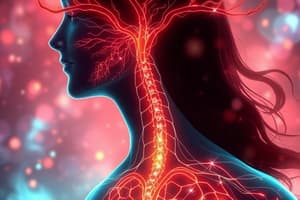Podcast
Questions and Answers
What is the main function of tropic hormones within the endocrine system?
What is the main function of tropic hormones within the endocrine system?
- Maintain fluid balance in the body
- Stimulate the production and secretion of hormones by other endocrine glands (correct)
- Stimulate cellular growth in target organs
- Regulate metabolism in target cells
Which of the following glands is commonly referred to as the 'master gland'?
Which of the following glands is commonly referred to as the 'master gland'?
- Pituitary gland (correct)
- Adrenal glands
- Pancreas
- Thyroid gland
What is a characteristic feature of hormones in the endocrine system?
What is a characteristic feature of hormones in the endocrine system?
- They are secreted in large volumes
- They maintain homeostasis via a positive feedback system
- They are directly delivered to target organs through ducts
- They are released in small amounts into the bloodstream (correct)
Which type of hormone is primarily involved in maintaining homeostasis through a negative feedback system?
Which type of hormone is primarily involved in maintaining homeostasis through a negative feedback system?
Which gland is responsible for producing hormones that influence metabolism?
Which gland is responsible for producing hormones that influence metabolism?
What is a primary role of the endocrine system related to human growth?
What is a primary role of the endocrine system related to human growth?
Which of the following is NOT a primary organ of the endocrine system?
Which of the following is NOT a primary organ of the endocrine system?
Which type of gland secretes hormones directly into the bloodstream?
Which type of gland secretes hormones directly into the bloodstream?
What is the primary role of tropic hormones?
What is the primary role of tropic hormones?
Which hormone is NOT secreted by the anterior pituitary gland?
Which hormone is NOT secreted by the anterior pituitary gland?
What is a characteristic feature of positive feedback systems?
What is a characteristic feature of positive feedback systems?
Which condition is associated with hypersecretion of hormones?
Which condition is associated with hypersecretion of hormones?
Which feedback system is primarily responsible for maintaining calcium homeostasis?
Which feedback system is primarily responsible for maintaining calcium homeostasis?
What primary function does calcitonin serve in the body?
What primary function does calcitonin serve in the body?
What role does the hypothalamus play concerning the pituitary gland?
What role does the hypothalamus play concerning the pituitary gland?
What clinical signs may indicate endocrine dysfunction?
What clinical signs may indicate endocrine dysfunction?
Which hormone increases metabolic rate in tissues?
Which hormone increases metabolic rate in tissues?
What determines secondary endocrine gland dysfunction?
What determines secondary endocrine gland dysfunction?
Which factor does NOT contribute to hyposecretion of hormones?
Which factor does NOT contribute to hyposecretion of hormones?
What is the key difference between glucocorticoids and mineralocorticoids?
What is the key difference between glucocorticoids and mineralocorticoids?
What physiological impact does oxytocin have during childbirth?
What physiological impact does oxytocin have during childbirth?
Flashcards are hidden until you start studying
Study Notes
Endocrine System Overview
- Endocrine organs include pituitary, pineal, thyroid, parathyroid, pancreas (islets of Langerhans), adrenal glands, ovaries, and testes.
- Function includes fluid balance, metabolism, growth, reproduction, aging, and stress response.
Hormone Functions and Types
- Hormones are chemical transmitters released in small amounts directly into the bloodstream.
- Categories of hormones based on chemical structure: amines, peptides, steroids, fatty acid derivatives.
- Tropic hormones stimulate other endocrine glands (e.g., TSH), while non-tropic hormones target specific cells or tissues (e.g., thyroxine).
Hormone Release Triggers
- Hormone release occurs due to stress, nervous system signals, negative feedback mechanisms, and tropic hormones.
- Examples of tropic hormones include TSH, FSH, LH, and ACTH.
Feedback Systems
- Negative feedback loops aim to maintain homeostasis.
- Positive feedback systems enhance hormone release in response to stimuli (e.g., oxytocin during childbirth).
Endocrine Imbalances
- Hormonal imbalances can lead to growth issues, mood changes, metabolism disorders, and sexual dysfunction.
- Dysfunctions can be classified into primary (e.g., tumors, autoimmune conditions) and secondary (external factors affecting gland function).
Assessment in Nursing Process
- Health history should include symptoms indicative of endocrine imbalance: energy levels, temperature tolerance, weight changes, thirst, bowel habits, hair patterns, and menstrual cycles.
- Physical assessments should check vital signs, hair distribution, facial changes, and signs of fatigue.
Diagnostic Approach
- Diagnostic tests include blood and urine tests, stimulation tests, and suppression tests.
Specific Glands and Their Functions
Pituitary Gland
- Known as the "master gland," it secretes tropic hormones influencing other glands.
- Divided into anterior (e.g., FSH, LH, ACTH, TSH, GH) and posterior lobes.
Thyroid Gland
- Produces thyroxine (T4), triiodothyronine (T3), and calcitonin.
- T3 and T4 influence growth, development, and metabolism, with iodine being crucial for hormone production.
- Regulated by a negative feedback system with TSH from the anterior pituitary.
Parathyroid Glands
- Four glands located on the thyroid, producing parathormone (PTH) to regulate calcium and phosphorus metabolism.
- Increased PTH raises blood calcium and lowers phosphorus through a feedback system.
Adrenal Glands
- Located above the kidneys, consisting of the adrenal medulla and cortex.
- Medulla releases catecholamines (epinephrine, norepinephrine) for the "fight or flight" response.
- Cortex produces glucocorticoids, mineralocorticoids, and androgens that regulate stress responses.
Studying That Suits You
Use AI to generate personalized quizzes and flashcards to suit your learning preferences.




